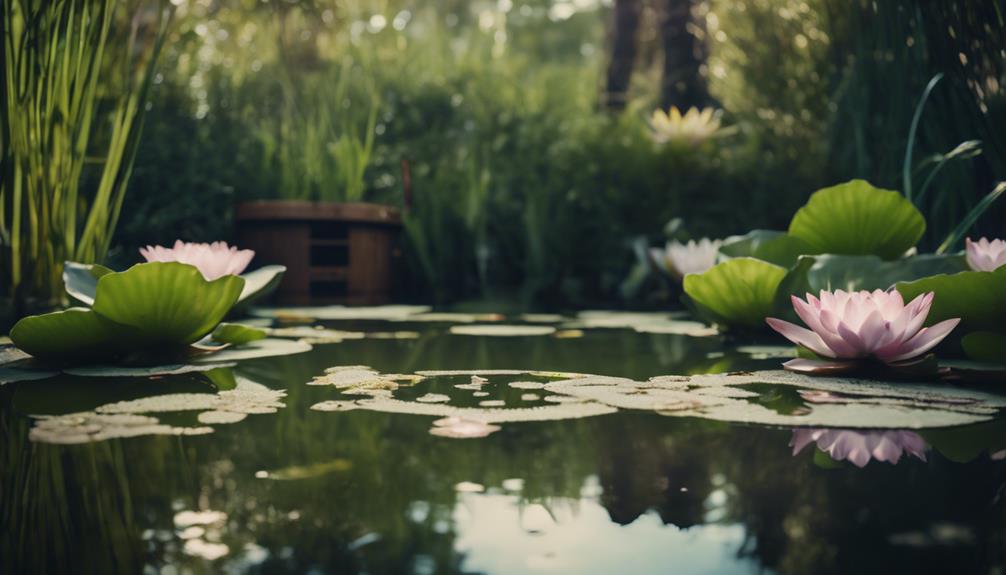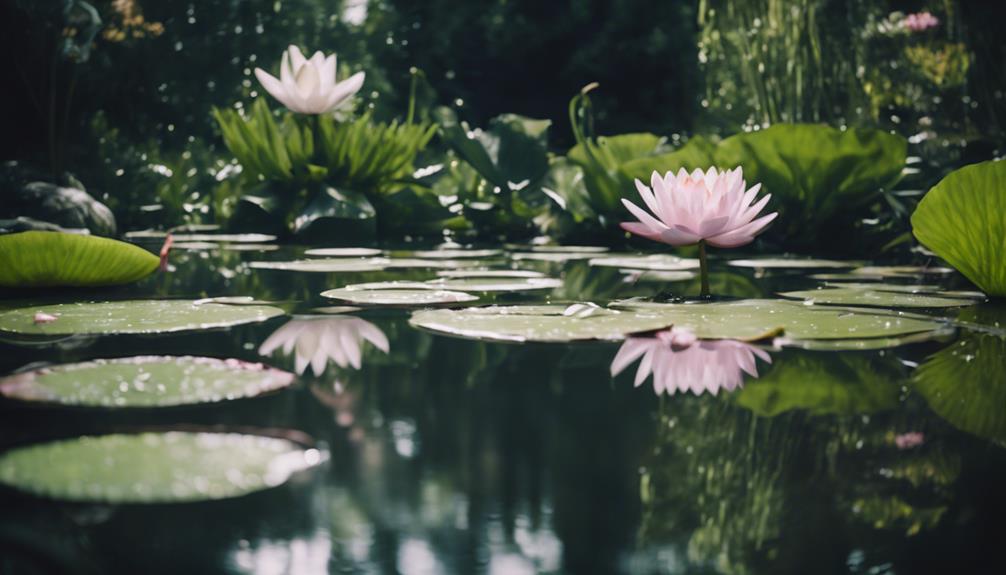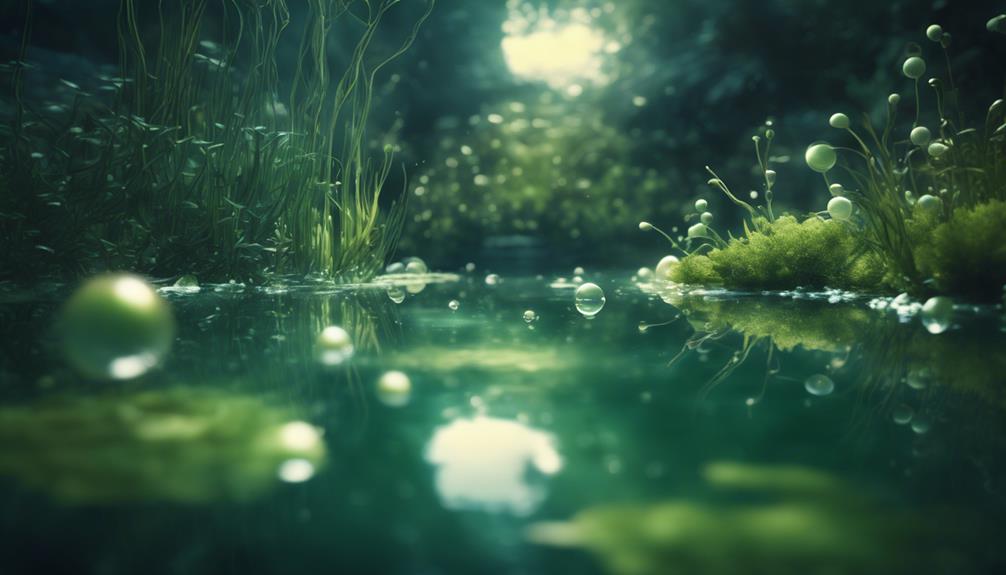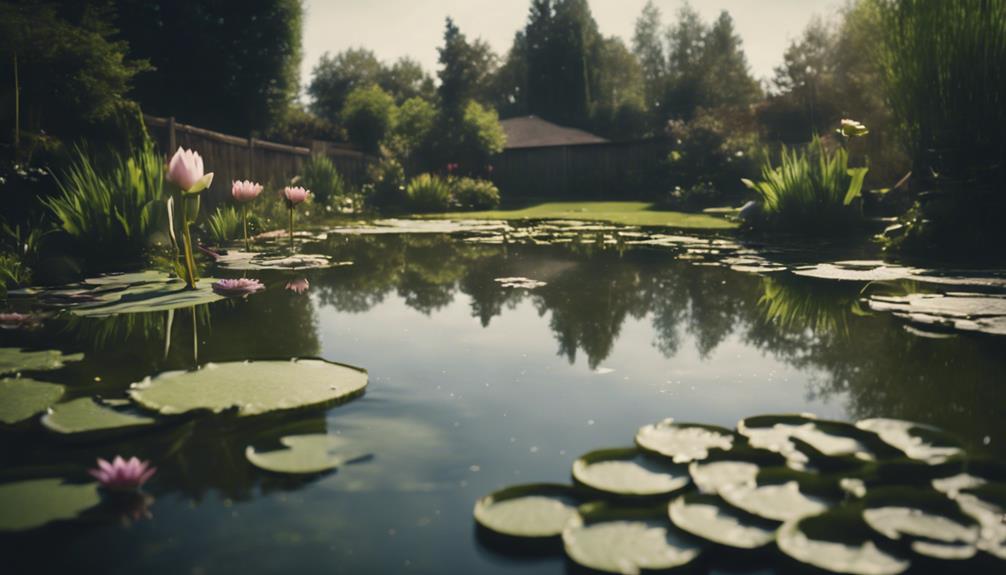You can effectively control algae growth in your garden pond or water feature by implementing a combination of DIY algae control systems that target the root causes of algae formation, including excessive nutrients, poor circulation, and inadequate aeration. Introduce natural methods like hydrogen peroxide, snails, and aquatic plants to limit sunlight penetration and nutrient availability. Beneficial bacteria and algae-eating fish can also be used to outcompete algae. Regular maintenance, proper water circulation, and aeration are vital in preventing algae buildup. Now that you've got a solid starting point, explore specific solutions and expert tips to tailor a thorough algae control strategy for your unique needs.
Table of Contents
Key Takeaways
- Introduce beneficial bacteria to outcompete algae for resources and maintain aquatic balance in your garden pond.
- Create a homemade algae scrub by mixing 1 cup of baking soda with 1 gallon of water for a natural DIY solution.
- Increase water circulation and aeration to prevent stagnation and reduce algae growth in your garden pond.
- Use vinegar as a natural algaecide by mixing 1 part vinegar with 10 parts water for a safe and effective DIY method.
- Regular surface cleaning and pond maintenance are vital in preventing algae buildup and promoting a healthy ecosystem in your garden.
Natural Algae Control Methods
When it comes to managing algae growth, you can turn to natural methods that aren't only effective but also environmentally friendly, and one of the most promising approaches is to utilize hydrogen peroxide as a natural and non-toxic solution.
As a reliable algae remover, hydrogen peroxide can be added directly to the water at a recommended dosage of 3/4 – 1 oz per 100 gallons of water. This method is particularly useful for controlling algae in small water features like fountains and bird baths.
In addition to hydrogen peroxide, you can also explore other natural methods to control water quality and prevent algae growth.
For instance, you can introduce snails and tadpoles to the water, which will feed on algae and mosquito larvae, providing a natural and eco-friendly solution.
Alternatively, you can use aquatic plants like Water Hyacinth, Water Lilies, and Lotus to limit sunlight penetration, preventing algae growth.
Hydrogen Peroxide Solution Guide
You can take your natural algae control methods to the next level by creating a hydrogen peroxide solution guide, which outlines the effective dosages and application procedures to tackle algae growth in your water features. This green stuff can be frustrating, but with the right approach, you can keep it under control.
Here's a breakdown of the recommended dosages and application procedures:
| Dosage | Water Volume |
|---|---|
| 3/4 – 1 oz | 100 gallons |
| 2-3 oz | 100 gallons (excessive algae) |
| – | – |
| – | – |
When using hydrogen peroxide, add it to the water basin and let it run through the system. Wait a day before checking the results and cleaning the filter regularly to prevent clogging. This natural and non-toxic solution dissipates quickly into the water and doesn't harm living creatures, making it a safe alternative to bleach and other harsh chemicals. By incorporating hydrogen peroxide into your routine, you'll be able to enjoy your water features without the hassle of excessive algae growth. Regular maintenance is key, so be sure to clean your fountain and pond regularly to prevent algae buildup.
Preventing Algae Growth Naturally

By implementing a few simple yet effective strategies, algae growth can be prevented naturally in your water features, saving you time and effort in the long run.
Regular maintenance is key, so make it a habit to clean your fountain and pond regularly.
You can also introduce plants that consume nutrients needed by algae, such as Elodea, Water Hyacinth, Water Lilies, and Lotus plants, to limit sunlight penetration and prevent algae growth.
A well-designed fountain system with proper water circulation can also help reduce algae growth.
Consider incorporating pond aeration systems to increase oxygen levels, making it difficult for algae to thrive.
Additionally, introducing algae-eating fish or beneficial bacteria to the ecosystem can help control algae growth naturally.
Widening the ditch or adjusting the pitch and slope can also improve water flow and drainage, reducing the likelihood of algae growth.
DIY Algae Removal Techniques
For effective DIY algae removal, turn to a combination of natural scrubbers, beneficial bacteria, and targeted water treatments that can be easily implemented to restore your water feature's health and clarity.
To begin, create a homemade algae scrub by mixing 1 cup of baking soda with 1 gallon of water. Apply this mixture directly to affected areas and scrub away the algae.
Alternatively, introduce beneficial bacteria to outcompete algae for resources. Products like Macro-Zyme contain beneficial bacteria compounds that can be added to the water.
You can also increase water circulation and aeration to prevent stagnation and reduce algae growth.
For a more targeted approach, use vinegar as a natural algaecide by mixing 1 part vinegar with 10 parts water and applying it directly to the affected area.
Regular surface cleaning and pond maintenance are also vital in preventing algae buildup.
Safe and Effective Chemical Control

When it comes to tackling algae growth, chemical control methods can be a reliable solution, offering a range of options that, when used correctly, can effectively eliminate unwanted algae.
As you explore algae treatment options, you'll find that hydrogen peroxide is a safe and effective chemical control method. For normal algae growth, you can use 3/4 to 1 oz of hydrogen peroxide per 100 gallons of water, and for excessive growth, 2-3 oz per 100 gallons.
Barley straw is another option, as it releases hydrogen peroxide when decomposing, killing algae.
If you're dealing with severe cases, Roundup (Glyphosate) can be used as a last resort, breaking down in sunlight and being non-toxic to mammals. However, you must exercise caution and follow product instructions to avoid harming plants and wildlife.
Always research and consult with experts before applying chemical control methods to verify you're using the right solution for your specific type of algae and ecosystem. By using safe dosages and following instructions, you can effectively eliminate algae and maintain a healthy garden.
Pitch and Slope Adjustment Tips
Adjusting the pitch and slope of your ditch is a crucial step in preventing water collection and reducing algae growth, as it enables increased water flow and drainage. By perfecting the slope, you can create a self-cleaning system that reduces the likelihood of algae formation.
| Ditch Maintenance | Slope Optimization | Water Flow |
|---|---|---|
| Regular cleaning | 1-2% slope for ideal results | Increased water flow reduces algae growth |
| Widening the ditch | Fixing the ditch pitch | Spreading water over a larger area increases evaporation |
| Removing debris and nutrients | Adjusting the slope | Reduces water collection and algae growth |
When adjusting the slope, aim for a 1-2% gradient to guarantee a smooth water flow. This will help reduce water collection and prevent algae growth. Additionally, widening the ditch can increase evaporation by spreading water over a larger area, further reducing the likelihood of algae formation. By incorporating these pitch and slope adjustment tips into your ditch maintenance routine, you'll be well on your way to creating a thriving, algae-free garden.
Beneficial Bacteria for Algae Control

As you explore beneficial bacteria for algae control, you'll discover that certain strains can outcompete algae for nutrients, effectively suppressing their growth.
You'll also learn about bacteria growth inhibitors that can be used to prevent the overgrowth of unwanted microorganisms.
Bacteria for Algae
By introducing beneficial bacteria, such as those found in products like Macro-Zyme, into your pond or lake, you can harness their natural ability to outcompete algae for nutrients, effectively controlling its growth. These beneficial bacteria are a natural and environmentally friendly way to control algae, as they're non-toxic to humans, pets, and wildlife, and don't harm aquatic plants.
Natural and non-toxic: Beneficial bacteria are safe for humans, pets, and wildlife, and don't harm aquatic plants.
Effective in small water bodies: Beneficial bacteria can be particularly effective in controlling algae in smaller water bodies, such as garden ponds, where water circulation and aeration may be limited.
Breaks down organic matter: Beneficial bacteria can break down organic matter, reducing the nutrient availability that algae need to thrive.
Maintains aquatic balance: Beneficial bacteria can help maintain aquatic balance by controlling algae growth, leading to improved water clarity and overall ecosystem health.
Regular maintenance and monitoring of water chemistry are still necessary when using beneficial bacteria for algae control, as they may not completely eliminate algae growth and can be affected by factors such as water temperature and pH levels.
Bacteria Growth Inhibitor
You can harness the power of beneficial bacteria as a bacteria growth inhibitor, directly competing with algae for nutrients and effectively suppressing its growth. By introducing beneficial bacteria into your aquatic system, you can create a balanced environment where algae struggles to thrive. These beneficial bacteria, such as those found in products like Macro-Zyme, can break down organic matter and recycle nutrients, making them unavailable to algae.
| Beneficial Bacteria | Role in Aquatic Balance | Impact on Algae Growth |
|---|---|---|
| Bacteria strains | Break down organic matter | Inhibit algae growth by consuming nutrients |
| Microbe colonies | Recycle nutrients | Make nutrients unavailable to algae |
| Beneficial bacteria | Produce byproducts like hydrogen peroxide | Directly inhibit algae growth |
Regular maintenance and monitoring of your aquatic system are necessary to guarantee the beneficial bacteria remain effective in controlling algae growth and maintaining a healthy ecosystem. By understanding the role of beneficial bacteria in aquatic balance, you can create a thriving environment where algae is kept under control.
Natural Algae Remover
As you explore natural algae removers, you might wonder: how do beneficial bacteria, such as those found in these products, effectively outcompete algae for resources, leading to a significant reduction in algae growth?
The answer lies in their ability to break down organic matter, consume excess nutrients, and produce byproducts that inhibit algae growth.
Beneficial bacteria consume excess nutrients, such as nitrogen and phosphorus, that algae need to thrive.
These bacteria break down dead plant material, reducing the amount of organic matter available for algae to feed on.
Beneficial bacteria produce byproducts, such as antibiotics and hydrogen peroxide, that inhibit algae growth.
As beneficial bacteria break down organic matter, they help clarify the water, making it less conducive to algae growth.
Frequently Asked Questions
How Do I Get Rid of Algae in My Garden?
You can prevent algae blooms in your garden by introducing algae feeders like Water Hyacinth, which absorb excess nutrients, and implementing algae prevention measures like regular cleaning and maintaining good water flow to reduce stagnation.
What Is the Best Natural Algae Killer?
"Can you really call yourself a nature lover if you're not using natural algae killers? You're in luck! Hydrogen peroxide, barley straw, and even snails are effective, eco-friendly solutions for algae prevention, offering a gentle yet potent approach to maintaining a thriving ecosystem."
How Do You Kill Algae Without Killing Plants?
You achieve algae resistance while ensuring plant safety through gentle removal methods, like using hydrogen peroxide, barley straw, or introducing snails and tadpoles, which target algae without harming your plants.
What Is the Best Method to Control Algae?
You'll be surprised to know that 70% of algae blooms are preventable! To effectively control algae, you'll need to identify the species, test the water, and implement prevention strategies, ensuring a balanced ecosystem that thrives without invasive algae growth.
Conclusion
You've made it to the end of our DIY algae control systems guide, and by now, you're equipped to tackle that pesky green growth in your garden.
Did you know that a single algae cell can multiply into over 1 million cells in just 24 hours? That's how quickly algae can take over!
With these 7 methods, you'll be able to prevent and remove algae, ensuring your garden remains healthy and thriving.
By implementing these techniques, you'll be saying goodbye to algae and hello to a balanced ecosystem.

